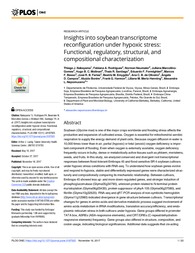Insights into soybean transcriptome reconfiguration under hypoxic stress: Functional, regulatory, structural, and compositional characterization.
Insights into soybean transcriptome reconfiguration under hypoxic stress: Functional, regulatory, structural, and compositional characterization.
Author(s): NAKAYAMA, T. J.; RODRIGUES, F. A.; NEUMAIER, N.; GOMES, J. M.; MOLINARI, H. B. C.; SANTIAGO, T. R.; FORMIGHIERI, E. F.; BASSO, M. F.; FARIAS, J. R. B.; EMYGDIO, B. M.; OLIVEIRA, A. C. B. de; CAMPOS, A. D.; BORÉM, A.; HARMON, F. G.; MERTZ-HENNING, L. M.; NEPOMUCENO, A. L.
Summary: Soybean (Glycine max) is one of the major crops worldwide and flooding stress affects the production and expansion of cultivated areas. Oxygen is essential for mitochondrial aerobic respiration to supply the energy demand of plant cells. Because oxygen diffusion in water is 10,000 times lower than in air, partial (hypoxic) or total (anoxic) oxygen deficiency is important component of flooding. Even when oxygen is externally available, oxygen deficiency frequently occurs in bulky, dense or metabolically active tissues such as phloem, meristems, seeds, and fruits. In this study, we analyzed conserved and divergent root transcriptional responses between flood-tolerant Embrapa 45 and flood-sensitive BR 4 soybean cultivars under hypoxic stress conditions with RNA-seq. To understand how soybean genes evolve and respond to hypoxia, stable and differentially expressed genes were characterized structurally and compositionally comparing its mechanistic relationship. Between cultivars, Embrapa 45 showed less up- and more down-regulated genes, and stronger induction of phosphoglucomutase (Glyma05g34790), unknown protein related to N-terminal protein myristoylation (Glyma06g03430), protein suppressor of phyA-105 (Glyma06g37080), and fibrillin (Glyma10g32620). RNA-seq and qRT-PCR analysis of non-symbiotic hemoglobin (Glyma11g12980) indicated divergence in gene structure between cultivars. Transcriptional changes for genes in amino acids and derivative metabolic process suggest involvement of amino acids metabolism in tRNA modifications, translation accuracy/efficiency, and endoplasmic reticulum stress in both cultivars under hypoxia. Gene groups differed in promoter TATA box, ABREs (ABA-responsive elements), and CRT/DREs (C-repeat/dehydration-responsive elements) frequency. Gene groups also differed in structure, composition, and codon usage, indicating biological significances. Additional data suggests that cis-acting ABRE elements can mediate gene expression independent of ABA in soybean roots under hypoxia.
Publication year: 2017
Types of publication: Journal article
Unit: Embrapa Soybean
Observation
Some of Embrapa's publications are published as ePub files. To read them, use or download one of the following free software options to your computer or mobile device. Android: Google Play Books; IOS: iBooks; Windows and Linux: Calibre.
Access other publications
Access the Agricultural Research Database (BDPA) to consult Embrapa's full library collection and records.
Visit Embrapa Bookstore to purchase books and other publications sold by Embrapa.

